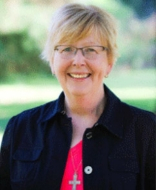
Novelists often write to us for advice about nun characters in their stories.
 The novelists have introduced us to a tough young woman from a gritty neighborhood who meets nuns there and is shocked to discover that she’s a lot like them. We’ve met Sister Marie, who works with the dedicated (and handsome and single) Doctor Andrew at a mission hospital in the Congo. We’ve learned about the elderly sisters who solve mysteries through prayer and skillful use of the internet. And then there’s Sister Mary—we’re still praying for her. She figured out who committed a crime and now they’re out to get her!
The novelists have introduced us to a tough young woman from a gritty neighborhood who meets nuns there and is shocked to discover that she’s a lot like them. We’ve met Sister Marie, who works with the dedicated (and handsome and single) Doctor Andrew at a mission hospital in the Congo. We’ve learned about the elderly sisters who solve mysteries through prayer and skillful use of the internet. And then there’s Sister Mary—we’re still praying for her. She figured out who committed a crime and now they’re out to get her!
What novelists tell us is that they want their nun characters to be as true to life as possible. They want authentic, nunly nuns. We’re happy glad to hear that! We appreciate accurate depictions of Catholic sisters and nuns!
One thing novelists ask about is sources of information, especially sources that are directly from congregations and sisters. Some have already gathered extensive research about religious life from databases, websites, and libraries. They’ve explored historical movements in areas such as theology, liturgy, scripture, and sisters’ education. They’ve considered social, cultural, and economic factors. Now they’re looking for something extra, for sources not well known to the public that will give them new insights about their nun character and what her everyday life is like.
To you, dear writers, first of all thank you for caring about our fictional sisters in religious life!
In regard to sources of information, there are many--far too many for a single blog post to cover. So we’ll offer just a few here to get you started (with the first, of course, being A Nun’s Life Ministry!). These sources may be especially helpful if you already know which congregation your nun character has joined.
The founders’ story. Many congregations have stories of their beginnings and what the lives of their early sisters were like. It’s incredible to read them—I’d classify most as action-adventure stories! Many congregations publish these stories on their websites. The spirit of a congregation’s founders is a powerful thing, and that spirit lives on in the sisters—past and present (and future). When you know the congregation’s founding story, you’ll have a sense of the values and characteristics that animate your nun character.
Constitutions (also known as The Rule). Constitutions are formal documents that describe the purpose, spirit, and functions of the congregation. They provide an overall context for your nun character’s life. On occasion, constitutions are updated, so it’s important to know the constitutions that are in effect during the time your nun character is in action.
Practices and customs of the congregation. Visit the archives of your nun character’s congregation for information about the day-to-day life of her and her sisters. For example, in my congregation’s archives, you’ll find Chronicles, a written log of sisters’ activities over several decades. You’ll also find information about how sisters prayed, the issues that mattered to them, where they served in ministry, the challenges they faced, how their theological perspectives evolved, and much more. Again, it’s important to keep in mind the time period in which your nun character is living. For example, an IHM sister in the early 1900s would have followed a horarium, an hour-by-hour schedule of prayer, work, and meals that governed the entire day of sisters in the congregation. This was no longer the case later on.
Photos and objects on display. Visit the Motherhouse of your nun character if possible. On our Motherhouse Road Trip podcasts, we’ve visited 40 Motherhouses or centers. In every one, we see images that tell us a lot about this congregation of sisters. Often we see historical images alongside current images, helping us to understand how the life of these sisters has grown and evolved. On one large Motherhouse campus, we were instructed to “turn left at the Mary statue,” only to realize there were over 10 Mary statutes in the vicinity! The congregation’s special dedication to Mary was evident. At the IHM Motherhouse, one of my favorite things is a plaque by the front door. It has a quote from a general superior decades ago: “Home is where each lives for the other and all live for God.” It says a lot about what it means to be an IHM, and why I am an IHM sister today.
We hope these sources help, and we’ll keep you in our prayers as you research and write about your nun characters!